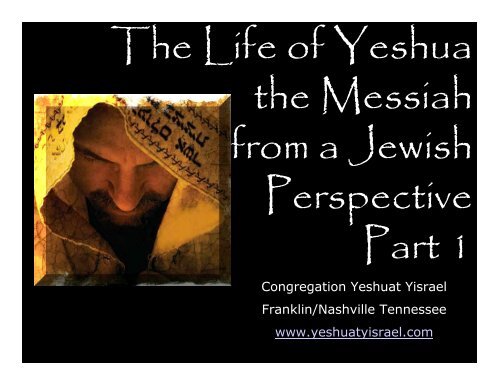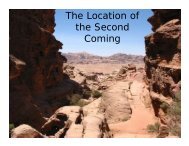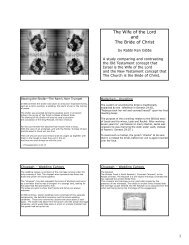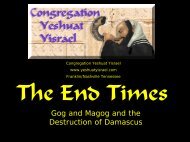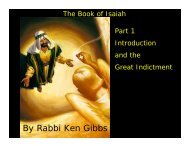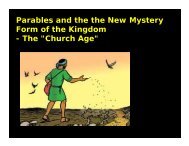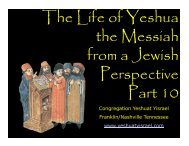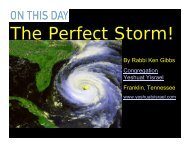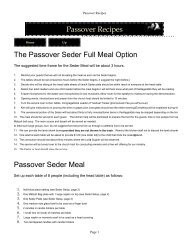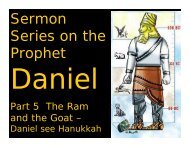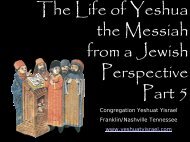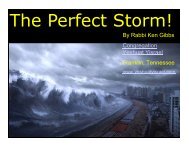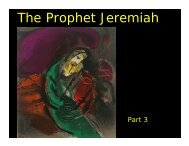The Life of Yeshua the Messiah from a Jewish Perspective Part 1
The Life of Yeshua the Messiah from a Jewish Perspective Part 1
The Life of Yeshua the Messiah from a Jewish Perspective Part 1
You also want an ePaper? Increase the reach of your titles
YUMPU automatically turns print PDFs into web optimized ePapers that Google loves.
<strong>The</strong> <strong>Life</strong> <strong>of</strong> <strong>Yeshua</strong><br />
<strong>the</strong> <strong>Messiah</strong><br />
<strong>from</strong> a <strong>Jewish</strong><br />
<strong>Perspective</strong><br />
<strong>Part</strong> 1<br />
Congregation <strong>Yeshua</strong>t Yisrael<br />
Franklin/Nashville Tennessee<br />
www.yeshuatyisrael.com
Congregation<br />
<strong>Yeshua</strong>t Yisrael<br />
Franklin/Nashville, Tennessee<br />
www.<strong>Yeshua</strong>tYisrael.com<br />
<strong>Yeshua</strong>tYisrael@gmail.com<br />
©2011 Congregation <strong>Yeshua</strong>t Yisrael<br />
All files use by permission only.<br />
Email us for permission and it will be granted.<br />
Please include this slide and give us credit.
Congregation <strong>Yeshua</strong>t Yisrael<br />
www.yeshuatyisrael.com<br />
Franklin/Nashville Tennessee<br />
<strong>Life</strong> <strong>of</strong> <strong>the</strong> <strong>Messiah</strong><br />
Introduction<br />
Various Views
Download <strong>the</strong> Harmony <strong>of</strong> <strong>the</strong> Gospels used in <strong>the</strong> Sermon Series.<br />
<strong>Life</strong>_<strong>of</strong>_<strong>the</strong>_<strong>Messiah</strong>/Harmony_<strong>of</strong>_<strong>the</strong>_Gospels.pdf
Introduction and <strong>the</strong><br />
Pre-Existing Messianic Person
Making Sense <strong>of</strong> <strong>the</strong> Gospels
Website resources<br />
www.<strong>Yeshua</strong>tYisrael.com
Harmony<br />
Ma<strong>the</strong>w Mark Luke John
<strong>The</strong> Four Gospels<br />
Mat<strong>the</strong>w<br />
Mark<br />
Luke<br />
John
1. <strong>The</strong> oral tradition <strong>the</strong>ory.<br />
Some have concluded that <strong>the</strong> basic sources for <strong>the</strong><br />
Gospels came <strong>from</strong> oral tradition, an oral testimony that<br />
developed around Jesus <strong>the</strong> <strong>Messiah</strong>. Normally such a<br />
testimony involved four steps: (1) <strong>The</strong> event occurred.<br />
(2) <strong>The</strong> event was told and repeated <strong>of</strong>ten enough so that<br />
it became widely known. (3) <strong>The</strong> event became fixed so<br />
that it was <strong>the</strong>n told exactly <strong>the</strong> same way. (4) <strong>The</strong> event<br />
was written down in an account. This view accounts for<br />
similarities in <strong>the</strong> stories but it fails to account for <strong>the</strong><br />
differences. Fur<strong>the</strong>rmore, why would an eyewitness <strong>of</strong> <strong>the</strong><br />
events limit himself to stories <strong>from</strong> oral tradition
2. THE “Q” <strong>the</strong>ory.<br />
A popular view today is that <strong>the</strong> biblical editors made use<br />
<strong>of</strong> various written sources to compile <strong>the</strong>ir accounts. This<br />
viewpoint usually posits <strong>the</strong> following: (1) <strong>The</strong> first<br />
written account was <strong>the</strong> Gospel <strong>of</strong> Mark. A major reason<br />
for this position is that only 7 percent <strong>of</strong> <strong>the</strong> Gospel <strong>of</strong><br />
Mark is unique, as 93 percent <strong>of</strong> Mark can be found in<br />
Mat<strong>the</strong>w and Luke. (2) In addition to Mark a second<br />
written document existed which basically contained<br />
discourse material. This document is known as “Q”, an<br />
abbreviated form <strong>of</strong> <strong>the</strong> German word for source, Quelle.<br />
<strong>The</strong> approximately 200 verses common to Mat<strong>the</strong>w and<br />
Luke which are not found in Mark must have come <strong>from</strong><br />
“Q”. (3) <strong>The</strong> editors used at least two o<strong>the</strong>r sources. One<br />
source reflects verses in Mat<strong>the</strong>w not found in ei<strong>the</strong>r<br />
Mark or Luke, and <strong>the</strong> o<strong>the</strong>r source reflects verses in<br />
Luke not found in ei<strong>the</strong>r Mat<strong>the</strong>w or Mark. This <strong>the</strong>ory<br />
with its lines <strong>of</strong> dependence could be charted in this way:
Mark<br />
“Q”<br />
Mat<strong>the</strong>w<br />
Luke
This <strong>the</strong>ory has several problems. First, it has difficulty<br />
with tradition. Conservative scholars have generally held<br />
that Mat<strong>the</strong>w was <strong>the</strong> first <strong>of</strong> <strong>the</strong> written Gospels. While<br />
not all conservatives agree, this tradition does have some<br />
weight behind it and should not be shrugged <strong>of</strong>f as “mere<br />
tradition” as sometimes tradition is correct. Second, this<br />
<strong>the</strong>ory cannot account for <strong>the</strong> fact that occasionally Mark<br />
made a comment that nei<strong>the</strong>r Mat<strong>the</strong>w nor Luke included.<br />
Mark wrote that <strong>the</strong> rooster crowed a second time (Mark<br />
14:72), but nei<strong>the</strong>r Mat<strong>the</strong>w nor Luke included that fact.<br />
Third, if Mark were <strong>the</strong> first Gospel, written after Peter’s<br />
death around a.d. 67-68, <strong>the</strong>n Mat<strong>the</strong>w and Luke would<br />
probably have been written later after <strong>the</strong> destruction <strong>of</strong><br />
Jerusalem in a.d. 70.
One would <strong>the</strong>n expect that destruction to have been<br />
mentioned as a fitting climax to <strong>the</strong> Lord’s words in<br />
Mat<strong>the</strong>w 24-25 or Luke’s statement in 21:20-24;<br />
however, nei<strong>the</strong>r mentioned <strong>the</strong> event. Fourth, <strong>the</strong><br />
greatest problem is <strong>the</strong> whole speculation about <strong>the</strong><br />
existence <strong>of</strong> “Q”.<br />
If such a document existed and were<br />
thought <strong>of</strong> so highly by Mat<strong>the</strong>w and<br />
Luke that <strong>the</strong>y quoted extensively<br />
<strong>from</strong> it, why did not <strong>the</strong> church also<br />
regard it highly and preserve it
<strong>The</strong> Four Gospels<br />
Mat<strong>the</strong>w<br />
Mark<br />
Luke<br />
John<br />
None <strong>of</strong> <strong>the</strong> human authors <strong>of</strong> <strong>the</strong> four Gospels<br />
identified himself by name. But that does not<br />
mean one cannot know who <strong>the</strong> authors were.<br />
An author may indirectly reveal himself within<br />
<strong>the</strong> writing, or his work may be well known in<br />
tradition as coming <strong>from</strong> him.
Mat<strong>the</strong>w-<br />
Many early church fa<strong>the</strong>rs cited<br />
Mat<strong>the</strong>w as its author, including<br />
Clement <strong>of</strong> Rome,<br />
Polycarp,<br />
Justin Martyr,<br />
Clement <strong>of</strong> Alexandria,<br />
Tertullian, and Origen.
Mat<strong>the</strong>w-<br />
Internal evidence also supports <strong>the</strong> fact that<br />
Mat<strong>the</strong>w was <strong>the</strong> author <strong>of</strong> <strong>the</strong> First Gospel. This<br />
book has more references to coins than any <strong>of</strong><br />
<strong>the</strong> o<strong>the</strong>r three Gospels. In fact this Gospel<br />
includes three terms for coins that are found<br />
nowhere else in <strong>the</strong> New Testament: “<strong>The</strong> twodrachma<br />
tax” (Matt. 17:24); “a four-drachma<br />
coin” (17:27), and “talents” (18:24). Since<br />
Mat<strong>the</strong>w’s occupation was tax collecting, he had<br />
an interest in coins and noted <strong>the</strong> cost <strong>of</strong> certain<br />
items. <strong>The</strong> pr<strong>of</strong>ession <strong>of</strong> tax collector would<br />
necessitate an ability to write and keep records.<br />
Mat<strong>the</strong>w obviously had <strong>the</strong> ability to write a book<br />
such as <strong>the</strong> First Gospel.
Mark-<br />
<strong>The</strong> unanimous testimony <strong>of</strong> <strong>the</strong> early church fa<strong>the</strong>rs is<br />
that Mark, an associate <strong>of</strong> <strong>the</strong> Apostle Peter, was <strong>the</strong><br />
author. <strong>The</strong> earliest known statement <strong>of</strong> this comes <strong>from</strong><br />
Papias (ca. a.d. 110), who quoted <strong>the</strong> testimony <strong>of</strong> John<br />
<strong>the</strong> elder, probably an alternate designation for <strong>the</strong><br />
Apostle John. Papias’ quotation named Mark as author<br />
and included <strong>the</strong> following information about Mark: (1)<br />
He was not an eyewitness follower <strong>of</strong> Jesus. (2) He<br />
accompanied <strong>the</strong> Apostle Peter and heard his preaching.<br />
(3) He wrote down accurately all that Peter remembered<br />
<strong>of</strong> Jesus’ words and works “but not in order,” that is, not<br />
always in chronological order. (4) He was Peter’s<br />
“interpreter,” probably meaning he explained Peter’s<br />
teaching to a wider audience by writing it down ra<strong>the</strong>r<br />
than translating Peter’s Aramaic discourses into Greek or<br />
Latin. (5) His account is wholly reliable
Mark-<br />
Internal evidence, though not explicit, is<br />
compatible with <strong>the</strong> historical testimony <strong>of</strong> <strong>the</strong><br />
early church. It reveals <strong>the</strong> following information:<br />
(1) Mark was familiar with <strong>the</strong> geography <strong>of</strong><br />
Israel, especially Jerusalem (cf. Mark 5:1; 6:53;<br />
8:10; 11:1; 13:3).<br />
(2) He apparently knew Aramaic, <strong>the</strong> common<br />
language <strong>of</strong> Israel (cf. 5:41; 7:11, 34; 14:36).<br />
(3) He understood <strong>Jewish</strong> institutions and<br />
customs (cf. 1:21; 2:14, 16, 18; 7:2-4).
Mark-<br />
In light <strong>of</strong> both external and internal evidence it is<br />
reasonable to affirm that <strong>the</strong> “John/Mark” in Acts and <strong>the</strong><br />
Epistles authored this Gospel. He was a <strong>Jewish</strong> Christian<br />
who lived in Jerusalem with Mary his mo<strong>the</strong>r during <strong>the</strong><br />
early days <strong>of</strong> <strong>the</strong> church.<br />
<strong>The</strong>ir home was an early Christian meeting place (cf. Acts<br />
12:12). It is possible it was <strong>the</strong> location <strong>of</strong> Jesus’ last<br />
Passover meal (cf. comments on Mark 14:12-16). Mark<br />
was probably <strong>the</strong> “young man” who fled away naked after<br />
Jesus’ arrest in Gethsemane (cf. comments on 14:51-52).<br />
Peter’s calling him “my son” (cf. 1 Peter 5:13) may mean<br />
Mark became a Believer through Peter’s influence.
Luke-<br />
<strong>The</strong> two books attributed to Luke (Luke and<br />
Acts) make up about 28 percent <strong>of</strong> <strong>the</strong> Greek<br />
New Testament. Luke is not mentioned by name<br />
in ei<strong>the</strong>r book. <strong>The</strong> only places where his name<br />
occurs in <strong>the</strong> New Testament are in Colossians<br />
4:14; 2 Timothy 4:11; and Philemon 24. Luke<br />
also referred to himself directly in <strong>the</strong> “we”<br />
sections <strong>of</strong> Acts (16:10-17; 20:5-21:18; 27:1-<br />
28:16).
Luke-<br />
Some conclude Luke must have been a Gentile<br />
for Paul differentiates him <strong>from</strong> <strong>the</strong> Jews (Col.<br />
4:10-14). Paul wrote that, <strong>of</strong> his fellow-workers,<br />
Aristarchus, Mark, and John were <strong>the</strong> only ones<br />
who were Jews. <strong>The</strong> o<strong>the</strong>rs (Epaphras, Luke, and<br />
Demas) were <strong>the</strong>refore probably Gentiles.<br />
Although if he was a Gentile he probably was a<br />
proselyte to Judaism before he became a<br />
believer. His view <strong>of</strong> Jerusalem and his<br />
understanding <strong>of</strong> <strong>Jewish</strong> idioms and customs<br />
would indicate that he had extensive knowledge<br />
<strong>of</strong> <strong>Jewish</strong> practices. Often referring to “GOING<br />
UP” to Jerusalem.
Luke-<br />
Paul referred to Luke as a physician (Col. 4:14),<br />
a fact which many try to corroborate <strong>from</strong><br />
passages in Luke and Acts.<br />
Until modern times church tradition uniformly has<br />
held Luke to be <strong>the</strong> author <strong>of</strong> Luke and Acts.<br />
According to tradition Luke was <strong>from</strong> Antioch.
Luke-<br />
Luke claimed to be a historian (Luke 1:1-4). He<br />
carefully researched his material for specific<br />
reasons. He consulted eyewitnesses for<br />
information (1:2). He may have ga<strong>the</strong>red certain<br />
details, such as facts on Jesus’ youth, <strong>from</strong> Mary<br />
herself (cf. 2:51). Luke also seemed to have had<br />
contacts with <strong>the</strong> Herodian court (cf. 3:1, 19;<br />
8:3; 9:7-9; 13:31; 23:7-12). Scholars do not<br />
agree on which sources Luke used in writing his<br />
Gospel. He may have reworked various source<br />
materials at his disposal in order to create a<br />
unified whole, written in his style, which reflected<br />
his rpose. All this, <strong>of</strong> course, was done under <strong>the</strong><br />
inspiration <strong>of</strong> <strong>the</strong> Holy Spirit
John-<br />
Internal evidence supplies <strong>the</strong> following chain <strong>of</strong><br />
connections regarding <strong>the</strong> author <strong>of</strong> <strong>the</strong> Fourth Gospel.<br />
(1) In John 21:24 <strong>the</strong> word “<strong>the</strong>m” refers to <strong>the</strong> whole<br />
Gospel, not to just <strong>the</strong> last chapter.<br />
(2) “<strong>The</strong> disciple” in 21:24 was “<strong>the</strong> disciple whom Jesus<br />
loved” (21:7).<br />
(3) From 21:7 it is certain that <strong>the</strong> disciple whom Jesus<br />
loved was one <strong>of</strong> seven persons mentioned in 21:2<br />
(Simon Peter, Thomas, Nathanael, <strong>the</strong> two sons <strong>of</strong><br />
Zebedee, and two unnamed disciples).<br />
(4) “<strong>The</strong> disciple whom Jesus loved” was seated next to<br />
<strong>the</strong> Lord at <strong>the</strong> Last Supper, and Peter motioned to him<br />
(13:23-24).
John-<br />
(5) He must have been one <strong>of</strong> <strong>the</strong> Twelve since only <strong>the</strong>y<br />
were with <strong>the</strong> Lord at <strong>the</strong> Last Supper (cf. Mark 14:17;<br />
Luke 22:14).<br />
(6) In <strong>the</strong> Gospel, John was closely related to Peter and<br />
thus appears to be one <strong>of</strong> <strong>the</strong> inner three (cf. John 20:2-<br />
10; Mark 5:37-38; 9:2-3; 14:33). Since James, John’s<br />
bro<strong>the</strong>r, died in <strong>the</strong> year a.d. 44, he was not <strong>the</strong> author<br />
(Acts 12:2).<br />
(7) “<strong>The</strong> o<strong>the</strong>r disciple” (John 18:15-16) seems to refer<br />
to <strong>the</strong> “disciple whom Jesus loved” since he is called this<br />
in 20:2.
John-<br />
(8) <strong>The</strong> “disciple whom Jesus loved” was at <strong>the</strong> cross<br />
(19:26), and 19:35 seems to refer to him.<br />
(9) <strong>The</strong> author’s claim, “We have seen His glory” (1:14),<br />
was <strong>the</strong> claim <strong>of</strong> someone who was an eyewitness (cf. 1<br />
John 1:1-4).<br />
Putting all <strong>of</strong> <strong>the</strong>se facts toge<strong>the</strong>r<br />
makes a good case for <strong>the</strong> author <strong>of</strong><br />
<strong>the</strong> Fourth Gospel having been John,<br />
one <strong>of</strong> <strong>the</strong> sons <strong>of</strong> a fisherman named<br />
Zebedee.
This is a Greek text called <strong>the</strong> Bodmer Papyrus. It dates<br />
<strong>from</strong> around 200 A.D. <strong>The</strong> text is John 1:1-13, plus <strong>the</strong><br />
first word <strong>of</strong> verse 14.
Gospel<br />
Mat<strong>the</strong>w<br />
Mark<br />
Luke<br />
John<br />
<strong>The</strong>me<br />
King <strong>of</strong> <strong>the</strong> Jews<br />
Servant <strong>of</strong> God<br />
Ideal Man<br />
Son <strong>of</strong> God<br />
Written to<br />
<strong>The</strong> Jews<br />
Romans<br />
Greeks<br />
<strong>The</strong> Church
Concept <strong>of</strong> each Gospel<br />
Mat<strong>the</strong>w-<br />
<strong>Yeshua</strong> King <strong>of</strong> <strong>the</strong> Jews<br />
If <strong>Yeshua</strong> was <strong>the</strong> King <strong>of</strong><br />
<strong>the</strong> Jews, why was <strong>the</strong><br />
Kingdom not set up.
Concept <strong>of</strong> each Gospel<br />
Mark-<br />
<strong>Yeshua</strong> <strong>the</strong> Ideal Servant<br />
Command received,<br />
Command carried out.
Concept <strong>of</strong> each Gospel<br />
Luke-<br />
<strong>Yeshua</strong> <strong>the</strong> Ideal Human<br />
Human Development and<br />
Achievement.
Concept <strong>of</strong> each Gospel<br />
John-<br />
<strong>Yeshua</strong> <strong>the</strong> Son <strong>of</strong> God<br />
What <strong>Yeshua</strong> said over what<br />
He did.
Concept <strong>of</strong> each Gospel<br />
John-<br />
Also developing a <strong>the</strong>me <strong>of</strong><br />
LIGHT VS DARKNESS
John- <strong>The</strong>me <strong>of</strong> “Sevens”<br />
Seven Signs or Miracles<br />
1. Changing water into wine 2:1-11<br />
2. Healing an <strong>of</strong>ficial’s son 4:46-54<br />
3. Healing an invalid at <strong>the</strong> Pool <strong>of</strong> Be<strong>the</strong>sda 5:1-18<br />
4. Feeding <strong>the</strong> 5,000 near <strong>the</strong> Sea <strong>of</strong> Galilee 6:5-14<br />
5. Walking on water 6:16-21<br />
6. Healing <strong>the</strong> man born blind 9:1-7<br />
7. Raising <strong>of</strong> Lazarus <strong>from</strong> <strong>the</strong> dead. 11:1-4
John- <strong>The</strong>me <strong>of</strong> “Sevens”<br />
Seven “I AM” Statements<br />
•I am <strong>the</strong> Bread <strong>of</strong> <strong>Life</strong> – John 6:35<br />
•I am <strong>the</strong> Light <strong>of</strong> <strong>the</strong> World – John 8:12<br />
•I am <strong>the</strong> Gate for <strong>the</strong> Sheep – John 10:7<br />
•I am <strong>the</strong> Good Shepherd – John 10:11<br />
•I am <strong>the</strong> Resurrection and <strong>the</strong> <strong>Life</strong> – John 11:25<br />
•I am <strong>the</strong> Way, Truth and <strong>the</strong> <strong>Life</strong> – John 14:6<br />
•I am <strong>the</strong> True Vine – John 15:1
Gospel<br />
Mat<strong>the</strong>w<br />
Mark<br />
Luke<br />
John<br />
Concept<br />
Why was <strong>the</strong> Kingdom not set up<br />
Command Given, Command Carried out<br />
Human Development<br />
What Jesus Said and<br />
Light Versus Darkness
Next week – <strong>The</strong> Pre-Existing <strong>Messiah</strong> and <strong>the</strong><br />
Genealogy <strong>of</strong> <strong>Yeshua</strong>
Download <strong>the</strong> Harmony <strong>of</strong> <strong>the</strong> Gospels used in <strong>the</strong> Sermon Series.<br />
<strong>Life</strong>_<strong>of</strong>_<strong>the</strong>_<strong>Messiah</strong>/Harmony_<strong>of</strong>_<strong>the</strong>_Gospels.pdf
<strong>The</strong> Aaronic Benediction<br />
Numbers 6:24-26<br />
.*r,m]v]yIwÒ y:yÒ *k]r,b;yÒ<br />
.+;N


